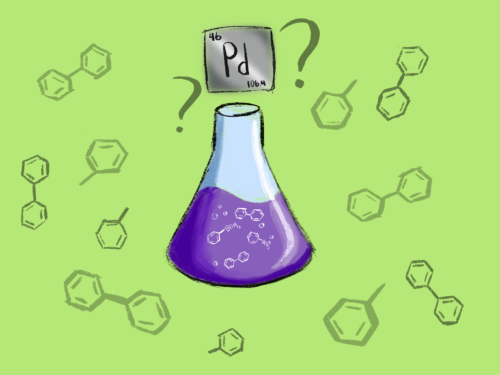Art Courtesy of Kara Tao
It was the right time for a breakthrough, but was it too good to be true? In early 2021, a research group led by Professor Hua-Jian Xu at the Hefei University of Technology claimed to have found a new, nitrogen-based catalyst for the Suzuki reaction. The Suzuki reaction is a popular method among organic chemists to create new bonds between two carbon atoms, and in the past, it has always involved a palladium catalyst—a substance that speeds up a chemical reaction.
However, researchers want to stop using palladium because the metal is toxic, difficult to recycle, and expensive, which limits their ability to use the Suzuki reaction to synthesize compounds in industry. Since 2003, scientists have promised a metal-free Suzuki reaction, but each time, they’ve found evidence of palladium contamination in their attempts. Mere traces of palladium on a dirty stir bar could be enough to start a Suzuki reaction, so researchers must be extra careful that there’s no palladium at all.
So, when the scientific community heard about Xu’s claims of a palladium-free Suzuki reaction, they were immediately skeptical. Although the Xu group included safeguards to avoid palladium contamination, scientists on X (formerly Twitter) quickly pointed out that Xu had used a palladium compound to make their Suzuki catalyst. Could palladium have somehow snuck into Xu’s experiment, just like his predecessors’? Chemistry professor Robin Bedford at the University of Bristol has been working with catalysts for over 30 years. “I was one hundred percent confident that it was palladium-catalyzed, and I needed [more evidence] to be shifted from that position,” Bedford said.
Bedford contacted other scientists who had doubted Xu’s work on social media and asked if they would join him in investigating his hunch that palladium contamination was at fault. After assembling a team of investigators, Bedford tried to figure out what might have gone wrong. To Bedford’s surprise, everything Xu did was reproducible to a remarkable degree—the numbers were within one to two percent of reported values, which is an unusual feat for synthetic chemistry. However, the main issue lay in what Xu didn’t do—a control experiment that created the catalyst without using palladium. When Bedford used a different, palladium-free route to make Xu’s catalyst, the catalyst no longer worked as advertised. Bedford did further testing which revealed that the metal was hiding in plain sight.
It turned out that palladium had nestled itself in a stable compound that made it challenging to detect. Xu used a process that was unable to extract the palladium from these compounds, leading him to believe that there wasn’t any palladium in the catalyst. However, when Bedford and his collaborators subjected it to hot, concentrated acid, the metal broke free. Unfortunately, Xu’s palladium-free Suzuki coupling wasn’t so palladium-free after all. Nine months after Xu’s initial announcement, Nature Catalysis published the concerns that researchers like Bedford had voiced. In response to growing doubt, Xu swiftly retracted his paper.
Although Xu failed to make a metal-free Suzuki reaction, his story is actually an example of success in the scientific method. “The scientific method is predicated on failure,” Bedford said. Science tends to fall in line with existing beliefs, but Xu pushed the boundary of what was conventionally thought to be possible. Because Xu had to retract his work, the research may seem to be, at first glance, reprehensible. In reality, his effort to expand the breadth of human knowledge is admirable. Retractions carry a negative stigma in the scientific community because they often arise from papers with manipulated data. To encourage scientists to retract papers with errors made in good faith, Bedford suggests creating a separate distinction for papers like Xu’s.
Bedford continues to search for new sustainable pathways to synthesize organic molecules. He is currently in the midst of publishing a proof-of-concept of an iron-catalyzed Suzuki coupling. Backed by almost 400 pages of data, Bedford’s efforts underscore just how difficult it has been to eliminate palladium from the Suzuki reaction. While his work may not be more efficient than currently available procedures, it’s a big step towards replacing palladium once and for all. One day, we might be able to cheaply make life-saving pharmaceuticals using a metal-free Suzuki reaction.

